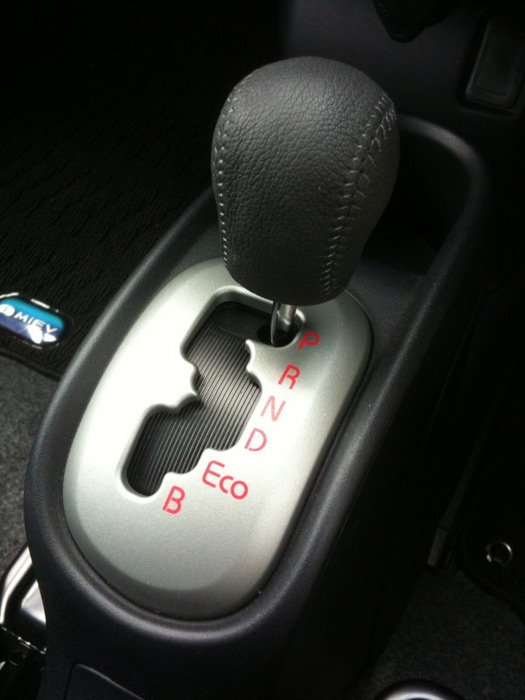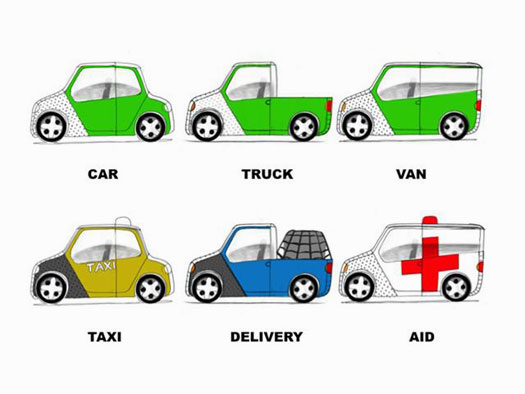
Yves Béhar's "people's car" concept based on OLPC principles
A highlight of last month’s Greener Gadgets conference in New York was a cute, emerald-colored product designed by Yves Béhar of FuseProject that is aimed for citizens of the developing world who might never have dreamed of possessing such an object.
Not a computer this time, but a car.
Inspired by what he learned as the industrial designer on the One Laptop Per Child (OLPC) project, Béhar presented a similarly conceived bare-bones automobile concept whose flexible design encourages do-it-yourself modification. Intended for dirt roads and in areas of undependable or no power infrastructure, the car is projected to have electrically driven wheels, but to accept various power plants. These might include batteries and charger, a small internal combustion engine, a hybrid system or even — in a scientifically over-optimistic suggestion — solar panels.
Just as the OLPC computer is customizable to encourage children to expand its utility, Béhar says, he made the car “hackable” so it could be powered and configured in any number of ways and even serve as a de facto portable generator. The front and rear forms are symmetrical, for easier and cheaper fabrication.
It would work well in China or India, Béhar believes, where he sees the electric vehicle infrastructure growing rapidly. “The developing world can leapfrog us in many ways, and this is one of them,” he said. He regards established auto companies as “very much stuck in a design rut.
“They need original design briefs and 21st-century business models.”
Intended as a set of ideas — a schematic and not a literal blueprint — Béhar’s “people’s car” was inspired by the Citroën 2CV (“Deux Chevaux”), the legendary French peasant car conceived for farmers to carry crops to market over dirt roads. Like the Model T Ford, the 2CV was rugged, had high clearance and was easily adaptable to other vehicle types. Béhar has continued this modularity with sketches of his little car transformed into a taxi, truck and ambulance.

Like the Citroën 2CV, Béhar's car can easily assume a range of vehicle types
And of course, he isn’t alone in his inspiration. Chrysler attempted a similar car with its Composite Concept Vehicle (CCV), designed by Bryan Nesbitt in 1997 for rural China as a conscious echo in more than name only of the 2CV. That car was to be built of composite panels from recycled soda bottles, simply assembled without tools and easy to repair. But the Chinese rejected it as naïve and condescending.
Instead, China adopted the automobile from the top down, with Buicks, the car owned both by last emperor Pu Yi and Republic of China leader Sun Yat-sen, leading the way. China’s highways were improved at a much faster rate than anticipated, though not at the expense of high-speed train lines.
Tata Motors’s Nano offers another take on the 2CV. Referring to a “Nano effect,” Geoff Wardle, director of advanced mobility research at Art Center College of Design, suggests that this small people’s car of India has made engineers and consumers everywhere think differently about all modes of transport. If Tata can produce a family car for $2000, Wardle says, which is about the average annual income in India, why not a cheaper motorbike or bicycle for everyone?
In some ways the 2CV is an imperfect archetype for cars designed for contemporary China, India or Africa. The French auto market had been established and growing for nearly 50 years before it came on the scene, conceived in a gesture of noblesse oblige by Citroën executive Pierre Boulanger as he toured French villages in 1936. His famous design mandate for the 2CV was summed up in a colorful image: to carry a dozen eggs across a plowed field without breaking them.
Influence even cuts the other way, with designs for the developing world having strange echoes in the developed one. Those ubiquitous windup manual power flashlights or radios, originally conceived for areas beyond the grid, have been widely purchased as emergency equipment in affluent countries. (They make sense for the auto glove box, where heat and cold quickly sap the batteries of conventional flashlights.)
The 2CV, similarly, came to appeal to French urbanites at least as much as to peasants. Samuel Beckett famously drove one in gray.
As Avinash Rajagopal suggested in his recent review of a Nano exhibition for Change Observer, many are resistant to providing cars of any kind to emerging nations. The automobile has the key disadvantage of wasting space and energy. But it also has the powerful benefit of offering flexibility for route and schedule, aiding entrepreneurs and leaders. The Model T and the 2CV revealed the car as a tool for innovation. The challenge is to avoid the problems of blight and traffic snarls while taking advantage of the benefits. Think of something like private-eye Precious Ramotswe’s little white Nissan truck in The No. 1 Ladies' Detective Agency, which she uses to build a small business, relate to a wider community and reveal information.
What Béhar’s concept supplies is an emphasis on versatility to fit unanticipated effects of design for developing areas. His ideal of “hackability” is desirable because it means pushing design downward to those who use things. It means putting innovation in the hands of the owner.


Comments [11]
03.18.10
01:58
Much as I generally admire Yves, this is more of the kind of thinking that got us into the mess we're in now.
03.18.10
06:08
The road of industrial progress marked by Fordism and car concept for personal / family mobility is akin to the Schrödinger cat experiment in which we've opened the box and found the cat dead.
03.18.10
11:48
maybe back to two wheeled carts pulled by pack animals or human power is better. or better yet, maybe we should just picture a world where everyone and everything stays put... mobility is so B.C...
03.19.10
02:49
Mr. Behar's model explores the idea that people need a basic method of transporting themselves and their belongings (or saleable goods), with emphasis placed on cost, power- and form-factor flexibility.
But I do agree with Ken that there is room to innovate. What if instead of having a flexible four-wheel platform, we have two-wheel scooter platforms that could be connected together with a bin or flatbed assembly transport larger goods? Lightweight, efficient, flexible, and reversible.
03.19.10
12:53
Outside the urban scenario, there is already tremendous amount of "design hacking" in the field of transportation design: old jeeps become de facto trucks, and old motorcycles are converted into an ingenious form of public transport called the chhakda. Google Images obliges, as always, with some excellent photographs: http://bit.ly/bPeZjk
But my contention is that when they can design vehicles for themselves, people in rural India tend to design communal vehicles rather than personal transport. The Chhakda is one colourful example, there are many others (shared auto-rickshaws, rental jeeps...).
I hope some visionary automaker actually introduces an affordable, hackable, "sandbox" automobile for rural India. Then we will really see some fun!
03.19.10
08:52
03.24.10
11:38
Surely the car is set too low for a more rougher terrain/ roads?
And in these very densely populated places, minor crashes and is quite common - this car seem to be built using very large parts, meaning that you'd have to replace a large bit of the car (costing more?)
Also, is the design made for children? Personally, I find the design patronizing and offending.
03.25.10
07:28
03.25.10
10:06
03.29.10
09:15
01.24.11
10:31